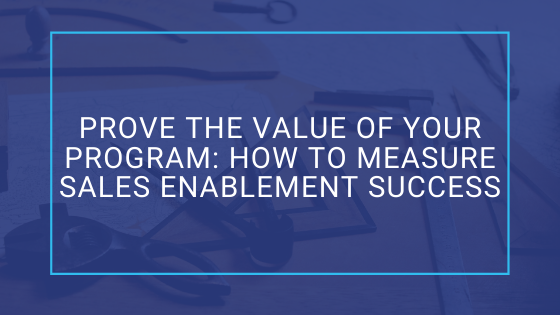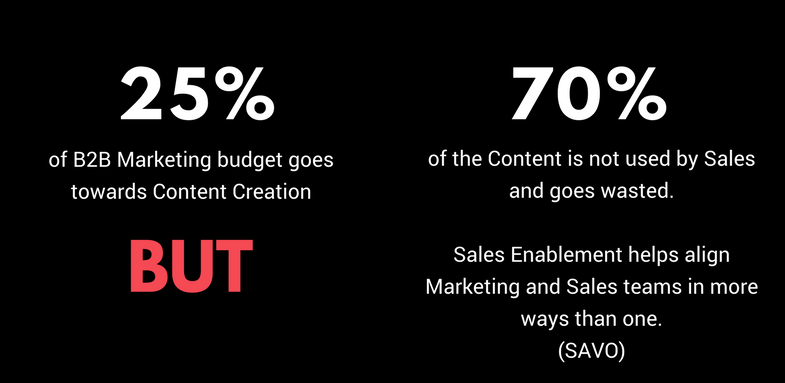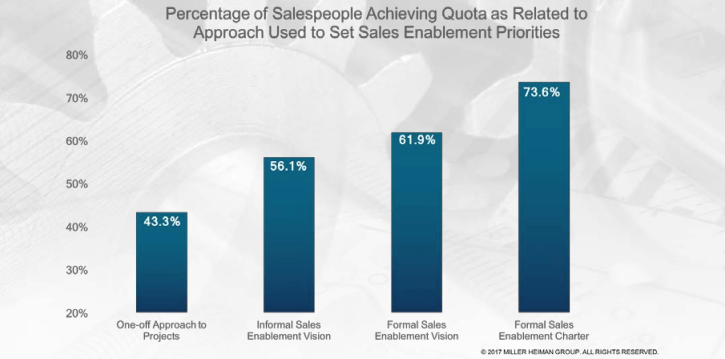Prove the Value of Your Program: How to Measure Sales Enablement Success
Tiffany Schultz
Making a case for sales enablement isn’t always the easiest thing to achieve, but once you secure that buy-in, measuring the success of your efforts is important. Even measuring the failures of your efforts is a must. Having insight into how things are performing allows you to know which activities to continue to invest in and which activities no longer serve you and your sales team. But sales enablement performance shouldn’t just be a concern for sales, marketing should also be actively measuring sales enablement success. Having the right metrics provides insight into what to expect from the investment that’s being made.
Aberdeen found that companies with excellent successful sales enablement programs have:
- 32% higher team sales quota attainment,
- 24% better individual quota achievement, and
- 23% higher lead conversion rate.
So how do you measure sales enablement success?

How to Measure Sales Enablement Success
When it comes to evaluating sales enablement efforts, different organizations may adopt varying metrics or KPIs to measure success. While some organizations might use different metrics based on their structure, we recommend starting with these:
Related Reading: A Roadmap to a Sure-Fire B2B Sales Enablement Strategy
Lead-to-Customer Conversion
If you want to measure the impact of your sales enablement activities, the lead-to-customer conversion rate is a good number to track. The ultimate goal of sales enablement is to help the sales team close more deals, right? Right. One thing to keep in mind is that this metric is influenced by other factors, such as the number and quality of the leads generated. But that doesn’t detract from the importance of it. If this rate is high, it indirectly indicates that your sales enablement efforts are working or at least improving.
Content Performance
Content for the sake of content doesn’t do anyone any good. Having compelling content, on the other hand, now that’s a different story. This is one of the most effective tools you can equip your salespeople with. But it’s important to measure how well content is performing. Determine this by analyzing the number of total downloads, number of likes, number of shares, ratings, etc. The more insight you have into what content is resonating best with your prospects, the better you can enable your sales team with those types of materials.

Attribution Reporting
Once you know how your content is performing, you can run attribution reports to see how much influence each piece of content had in helping turn leads into customers. They will of course view many pieces of content, but this report provides insight into what content they read and are most interested in late in the buyer’s journey.
Onboarding and Proficiency
When it comes to sales enablement and how to measure success, you’ll want to measure the effectiveness of each sales rep and how it relates to how long it takes for onboarding and ramping, but also proficiency. Ensure that sales teams are well-versed in the processes and materials. Cutting down the ‘time to productivity’ is a primary parameter that can help prove the effectiveness of your training efforts.
Companies with a dedicated sales enablement function improved their sales training effectiveness by 29%.
– Brainshark “6 Sales Enablement Statistics You Have to See (2018)
Win/Loss Rates
How are you stacking up against the competition? Looking at your win/loss rate can help you measure how well you’re equipping your sales team when they’re up against competitors.

Actual Time Spent Selling
Enablement programs that are set up properly should empower sales reps by providing all the tools necessary to sell when they need them. By having these tools and resources at the ready, it allows more time for the reps to actually sell and close more deals. Measure the percentage of each rep’s time spent on the actual sale and attainment. Allowing them to focus more and have fewer disruptions in their sales process should increase their close rate and overall revenue.
Measure Against Sales Goals
At the end of the day, the goal of sales enablement is exactly that: enable your sales team. Enable them to sell effectively, sell confidently with the materials they need, when they need them, and to close more deals. So it comes down to are they meeting or exceeding their sales goals? Are your enablement efforts and activities creating an effective sales team?
Hint: if the answer isn’t yes, it’s time to readjust and look at what activities are actually serving you and which ones are hurting your enablement efforts.
Sales Enablement KPIs
As we mentioned, what metrics are most important can vary from organization-to-organization. Ultimately it comes down to what are your goals and which metrics are going to help move you closer to achieving those goals. Regardless of what metrics you choose to narrow in on, when measuring your sales enablement KPIs, it’s important to remember to:
- Analysis even before activities: If you don’t have a sales enablement program yet, that doesn’t mean you can’t still measure your sales activities and success. By doing this, you’ll have a baseline to start from to measure the impact and success of your sales enablement activities once you do implement them.
- Review results frequently: This is an iterative process, sales enablement. So don’t just set KPIs and call it a day. Be sure to review results frequency so you can pivot your efforts if needed. It’s also good practice to get a regular cadence of reviewing results with leadership to show them the impact of the enablement efforts. Especially if those results are good, it will show the ROI of the investment.
- Adjust KPIs if necessary: Just as you will refine your sales enablement process and materials, make sure you do the same with your KPIs. Tailor them to your sales team, materials, and sales enablement processes. As part of reviewing results frequently, be checking to make sure you have the right KPIs.
- Capture proficiency scores: When it comes to measuring program effectiveness, don’t forget that sales is an important factor. Make sure all your sales reps are at least on the same level from the beginning. This will make it easier to see changes in individual sales rep success and how that relates to sales enablement materials, strategies, and techniques being used.

Continual Feedback Loops
Once you know how to measure sales enablement success and what to be looking at, it’s important not to stop there. These efforts and iterations on the enablement activities should be an ongoing process, with sales and marketing aligning closely and sharing information frequently.
Salespeople are the ones interacting 1:1 with prospects and new customers and as a result, they will have important insights on how marketing efforts can be improved or strengthened. Consider things like any direct feedback from customers. Did they mention liking or even disliking a specific piece of content or resource?
This feedback is important to know what content is or isn’t resonating with your personas and customers. It gives marketing direction on what to focus their efforts on. But this is a two-way street. Marketing should be communicating and sharing their insights with sales as well. Analytics like open rates, conversion rates, traffic, etc. can be helpful for sales teams. Having that open, frequent dialog around set key performance indicators is a must.



